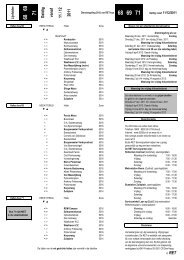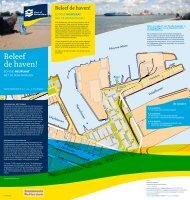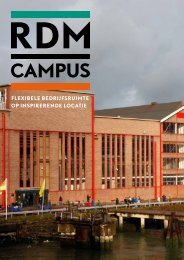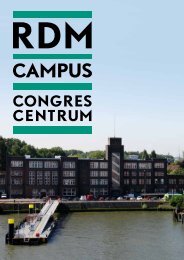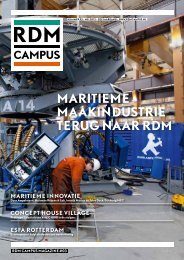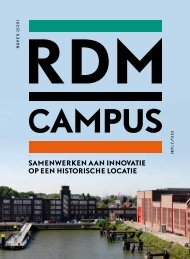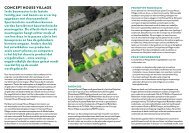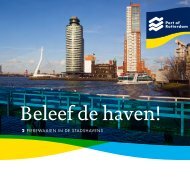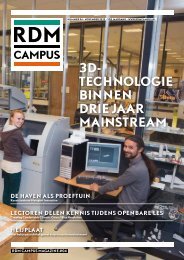Creating Comfortable Climatic Cities - RDM Campus
Creating Comfortable Climatic Cities - RDM Campus
Creating Comfortable Climatic Cities - RDM Campus
Create successful ePaper yourself
Turn your PDF publications into a flip-book with our unique Google optimized e-Paper software.
28 <strong>Creating</strong> <strong>Comfortable</strong> <strong>Climatic</strong> <strong>Cities</strong>29<strong>Creating</strong> <strong>Comfortable</strong> <strong>Climatic</strong> <strong>Cities</strong>Biobased materialsReducing the need for resources through reuse and upcycling is the first step inresource efficiency. But recycling will never meet the total demand for materials ona large scale. A second strategy that represents a huge opportunity for the buildingsector is the use of renewable or biobased materials. If produced on a large enoughscale, this renewable source of materials has more favourable environmental impactsthan most mineral based options. For many architects, however, the use of naturalmaterials is seen as a limitation that leads to cliché Green buildings (Maas et al., 2010).It is therefore imperative that diverse contemporary architectural applications ofbiobased materials are developed to stimulate the use of these environmentallyfriendly products. Their uptake can be accelerated by producing architectural worksof international allure that make use of biobased materials. If tackled at the nationalscale, the production of biobased materials could radically impact the agricultural,energy and building sectors, contributing to the growth of a Green economy.It is clear that issues relating to climate change, energy poverty and resource depletionrepresent huge opportunities for the building sector. To be able to respond to thischallenge designers need to expand their knowledge of techniques and materials.At the moment, examples of climate responsive architecture in which appropriatetechnologies and material use are brought into balance with sociocultural influencesare thin on the ground. If Green is to escape the commercialisation of the mainstreamand develop into a truly integral sustainable approach, the biggest obstacle of all isundoubtedly economic. It can be argued that economic engineering and new temporalmodels of financing are currently more essential for the transition to a new Green erathan technical innovation.03. Incentives for ChangeEuropean directivesIf the current trends continue, the global population is expected to grow by 30%to around nine billion people by 2050. Given the exponential growth of countrieslike China and India, and their increasing levels of welfare and consumption, there issincere cause for concern. Increasing resource efficiency will become key in securinggrowth and jobs in Europe. The European Union aims to develop a strategy to createa ‘circular economy’ based on a recycling society, with the aim of reducing wastegeneration and using waste as a resource (see Figure 10A and 10B). By reducing relianceon increasingly scarce fuels and materials, boosting resource efficiency can improvesecurity of raw materials supply, making the economy more resilient to futureincreases in global energy and commodity prices (European Commission, 2011).In order to achieve this, new products and services need to be developed at the regionaland local scales. New ways to reduce inputs, minimise waste, change consumptionpatterns and optimise production processes will need to be found. This cannot beachieved without the development of innovative management and business models,and improved logistics. It is expected that this will stimulate technological innovation,improve productivity, reduce costs, boost employment in the Green technologysector, open up new export markets and deliver more sustainable products thatbenefit customers.In terms of energy resources, there are two dominant issues at European and nationallevels: the EU is becoming increasingly dependent on external energy sources, andgreenhouse gas emissions are on the rise. Energy consumption for building-relatedservices accounts for approximately one third of the total EU energy consumption.Here, the greatest gain can be made by influencing energy demand and one way toreduce energy consumption is by improving energy efficiency. To this end, in 2010the EU adopted a directive stipulating that all new buildings must be energy neutralby 2020 (2050 for the existing stock). The directive forms part of the communityinitiatives on climate change (commitments under the Kyoto Protocol) and stipulatesthat the building sector must adapt to fully integrate energy concepts and resourceefficiency in the design of buildings, the urban fabric and landscape (Directive2010/31/EU).The result of this European directive is that provincial and local authorities acrossthe country have started offering major incentives to encourage Green building.An example of how fiscal incentives can contribute to energy efficiency in the builtenvironment are the Green Deals between government and industry. Public-privatepartnerships are seen as the best way to generate a more sustainable economy,removing barriers and opening the doors to innovation. The introduction of the energylabel in 2008 is another form of incentive. Homeowners must produce an energylabel when selling or renting their home. The expectation is that this will stimulate theprivate sector to retrofit the existing stock, with the 2050 energy ambitions in mind.





